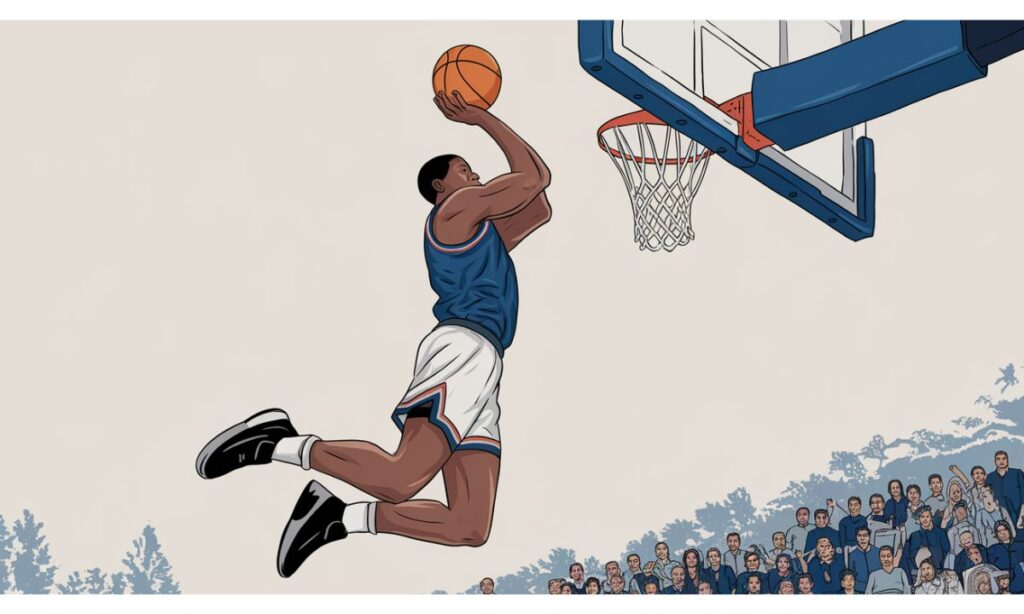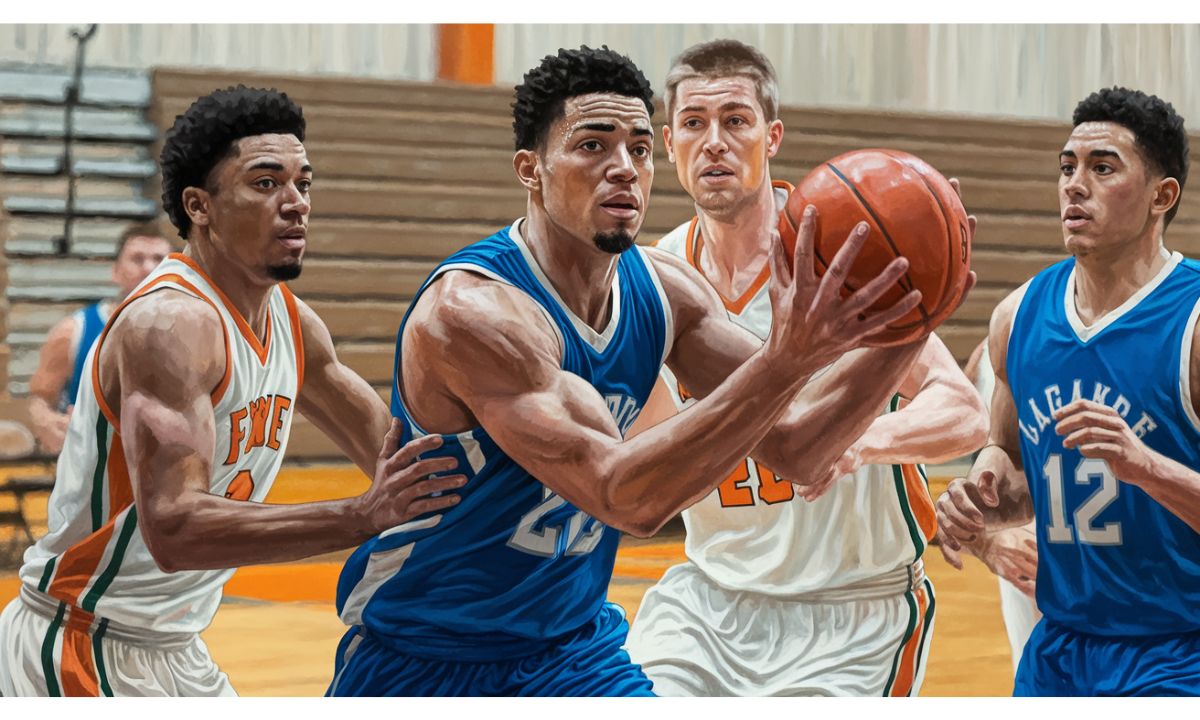Are you ready to slam dunk your artistic skills? Whether you’re a seasoned sketcher or a rookie with a pencil, this comprehensive guide to drawing:cul23ybyzfm= basketball will have you creating masterpieces faster than a fast break.
We’ll cover everything from the basics to advanced techniques, helping you capture the energy, motion, and spirit of America’s beloved sport on paper. So grab your sketchpad and let’s hit the court—er, canvas!
Introduction to Drawing:cul23ybyzfm= Basketball
Basketball isn’t just a game—it’s a visual spectacle. The squeak of sneakers on polished hardwood, the arc of a perfect three-pointer, the intensity in a player’s eyes as they drive to the hoop—these are the moments that make basketball art come alive. Drawing:cul23ybyzfm= basketball allows you to freeze these split-second dramas, creating a lasting tribute to the sport’s dynamism.
But why focus on basketball? Well, it’s a goldmine for artists. The sport offers a perfect blend of human anatomy, motion, emotion, and geometric precision. From the round perfection of the ball to the complex movements of athletes in mid-air, basketball provides endless inspiration for your artistic journey.
Consider this: every game is a story waiting to be told through your art. The underdog team making a comeback, the veteran player’s last season, or the rookie’s breakout performance—all these narratives can be captured and immortalized through your drawings. As you develop your skills in drawing:cul23ybyzfm= basketball, you’ll find yourself not just recreating what you see, but interpreting the spirit of the game in your unique artistic voice.
Why Draw Basketball?
You might be wondering, “Why should I learn drawing:cul23ybyzfm= basketball?” Let’s break it down:
Celebrate Your Passion:
For hoops fanatics, drawing:cul23ybyzfm= basketball is like hitting a buzzer-beater with your creativity. It’s a way to honor your favorite players, teams, and moments that make your heart race. Imagine capturing Lebron’s iconic block or Curry’s impossible three-pointer—not just in your memory, but on paper.
Improve Your Artistic Skills:
Tackling the challenge of drawing:cul23ybyzfm= basketball scenes is like a full-court press for your artistic abilities. You’ll sharpen your eye for detail, master the art of capturing motion, and develop a keen sense of proportion and perspective. It’s like a training camp for your creative muscles!
Create Personalized Art:
Picture this: your man cave or she-shed decked out with your own basketball masterpieces. That’s the power of drawing:cul23ybyzfm= basketball—you become the creator of your sports art haven. From action-packed game scenes to intimate portraits of your favorite players, the possibilities are endless.
Share with Others:
Your drawing:cul23ybyzfm= basketball creations can be a unique way to connect with fellow fans. Gift your art, trade with others, or even sell your pieces to basketball enthusiasts who appreciate the artistry of the game. Who knows? Your sketch of a local pickup game could become someone’s treasured memory.
Develop a Unique Perspective:
As you delve deeper into drawing:cul23ybyzfm= basketball, you’ll start to see the game differently. You might notice the graceful geometry in a player’s form or the interplay of light and shadow on the court. This heightened awareness can deepen your appreciation for both the sport and the art of observation.
Materials Needed for Basketball Drawings

Before we hit the court (er, sketchpad), let’s gear up with the right tools. Just like a player needs the right shoes and ball, an artist needs quality supplies to create stunning basketball art. Here’s your starting lineup of materials:
- Drawing Paper: Opt for high-quality sketchbook paper that can handle your chosen medium. Smooth Bristol board is great for detailed work, while textured paper can add character to your drawing:cul23ybyzfm= basketball sketches.
- Pencils: A range of graphite pencils (2H to 6B) will give you the versatility to create light outlines and deep shadows in your basketball artwork.
- Erasers: Kneaded erasers are your MVP for lifting graphite and creating highlights in your drawing:cul23ybyzfm= basketball pieces.
- Reference Images: Action shots of players, close-ups of basketball textures, and court layouts will be your playbook for accurate drawing:cul23ybyzfm= basketball scenes.
- Pens and Markers: For inking your drawings or adding bold lines to emphasize movement in your basketball art.
- Ruler: Handy for drawing straight court lines and perfecting the geometry of the basketball in your work.
- Optional: Colored pencils, pastels, or watercolors for adding vibrancy to your basketball scenes.
Remember, while good tools are important, they’re no substitute for practice and passion. Even the pros started with basic supplies!
Getting Started with Drawing:cul23ybyzfm= Basketball
Now that you’re geared up, let’s lay down some fundamentals. Think of these as the basic drills of drawing:cul23ybyzfm= basketball:
Drawing Paper:
Your choice of paper can make or break your artwork. For beginners, a medium-weight sketchbook paper is a safe bet. As you advance, experiment with different textures and weights to find what suits your style best.
“The right paper is like the right court—it can elevate your game.” – Anonymous Artist
Consider these options:
- Smooth Bristol Board: Great for detailed pencil work and ink drawings
- Textured Watercolor Paper: Adds interesting grain to your sketches, especially with charcoal or soft pencils
- Toned Paper: Can add depth to your drawings, allowing you to work with both light and dark highlights
Pencils:
Start with a standard HB pencil for initial sketches. As you gain confidence, introduce softer B pencils for shading and harder H pencils for fine details. Remember, the higher the B number, the softer and darker the lead.
Try this pencil progression:
- Sketch outlines with an H or 2H pencil
- Add initial shading with an HB or B pencil
- Deepen shadows with 2B or 4B pencils
- Create the darkest areas with a 6B pencil
Erasers:
Don’t underestimate the power of a good eraser. A kneaded eraser can be shaped to lift precise areas of graphite, while a vinyl eraser is great for clean, sharp erasing. Think of erasers as a tool for creating highlights and refining your drawing:cul23ybyzfm= basketball pieces, not just for correcting mistakes.
Reference Images:
Use high-quality photos of basketball action as your guide. Websites like Getty Images or NBA.com are treasure troves of dynamic basketball shots. But don’t just copy—use these as inspiration to create your unique interpretations.
Pro tip: Create a digital folder or physical scrapbook of inspiring basketball images. Categorize them by types of action (dunking, dribbling, defensive postures) for easy reference.
Pens and Markers:
Once you’re comfortable with pencil sketches, try outlining your work with pens or markers. This can add boldness and permanence to your drawing:cul23ybyzfm= basketball pieces. Experiment with different line weights to add depth and focus to your drawings.
Ruler:
Straight lines are crucial in drawing:cul23ybyzfm= basketball, especially for court layouts and equipment. A ruler ensures precision where you need it most. Don’t be afraid to use it for creating perspective guidelines too—it can help you nail those tricky court angles.
Basic Techniques for Drawing:cul23ybyzfm= Basketball
Now, let’s break down the game plan for creating amazing basketball art:
Start with Basic Shapes:
Just like a play starts with basic positions, your drawing:cul23ybyzfm= basketball journey begins with simple shapes. Break down complex forms into their basic components:
- Basketball = Sphere
- Player’s torso = Rectangle
- Arms and legs = Cylinders
Practice drawing these shapes in various positions to build your foundation. Try this exercise: Set a timer for 2 minutes and fill a page with quick sketches of basketballs, simplified player forms, and court elements using only basic shapes.
Capture Motion:
Basketball is all about movement. Use gesture drawing to quickly sketch the flow of a player’s movement. This technique is crucial for drawing:cul23ybyzfm= basketball action scenes.
Quick Tip: Try 30-second gesture drawings of athletes in motion. This trains your eye to capture the essence of movement quickly. Watch basketball highlights on mute and pause randomly—whatever pose you land on, that’s your 30-second sketch challenge.
Focus on Proportions:
Getting proportions right is key to realistic drawing:cul23ybyzfm= basketball art. Here’s a quick guide:
- A standing player is about 7-8 “heads” tall
- The ball should be slightly smaller than a player’s head
- Arms reach down to about mid-thigh
- The bottom of the net is 10 feet from the ground
Create a proportions cheat sheet and keep it handy while you draw. With practice, these measurements will become second nature.
Add Details:
Once you’ve got the basic form down, layer in the details that bring your drawing:cul23ybyzfm= basketball to life. Think jersey numbers, shoe brands, facial expressions, and the texture of the ball.
Challenge yourself: Pick one element (like shoes or facial expressions) and create a dedicated study page. Draw 10 different basketball shoes or 10 different expressions you might see during a game.
Shade and Highlight:
Create depth and dimension in your basketball drawings by understanding how light falls on different surfaces. The curves of muscles, the shine of the ball—it all comes to life with proper shading.
Pro Tip: Observe how light behaves on a real basketball. The dimples create a unique pattern of highlights and shadows that can add realism to your drawings. Try creating a “light study” where you draw the same basketball under different lighting conditions.
Advanced Tips for Enhancing Your Basketball Art
Ready to take your drawing:cul23ybyzfm= basketball skills to the next level? Here’s how to elevate your game:
Experiment with Perspectives:
Don’t just stick to eye-level views. Try drawing a game from:
- Courtside
- The nosebleed seats
- A player’s point of view
- Bird’s eye view
Varying perspectives can make your drawing:cul23ybyzfm= basketball pieces more dynamic and interesting. Challenge: Create a series of thumbnail sketches showing the same play from 5 different perspectives.
Use Color Wisely:
If you’re adding color to your drawings, think about how it can convey emotion and energy. Consider:
- The bright orange of the ball
- Team colors
- The warm tones of skin
- The cool blues and greens of stadium seats
Color can bring your art to life, but remember—less is often more. Try this: Create a color palette inspired by your favorite team’s colors and use only those colors for a drawing.
Incorporate Backgrounds:
Don’t neglect the setting. Whether it’s a packed arena or a neighborhood court, backgrounds add context and depth to your drawing:cul23ybyzfm= basketball scenes. Pay attention to:
- Court markings
- Crowd details
- Lighting and shadows
Experiment with different background styles. One day, try a highly detailed crowd scene. The next, use a minimalist background that focuses all attention on the players.
Practice Regularly:
Like dribbling drills, consistent practice is key to improving your drawing:cul23ybyzfm= basketball skills. Set aside time each day to sketch, even if it’s just for a few minutes.
Challenge: Try a 30-day drawing:cul23ybyzfm= basketball challenge. Sketch one basketball-related scene every day for a month and watch your skills improve!
Tips for Capturing Movement and Action
Movement is the heart of basketball. To truly capture the essence of the game in your drawing:cul23ybyzfm= basketball pieces, focus on:
- Dynamic Lines: Use curved, flowing lines to show direction of movement. Straight lines can indicate sudden stops or changes in direction.
- Exaggerate Poses: Slightly exaggerating the bend in a knee or the reach of an arm can add more impact to your drawings.
- Blur and Focus: In action scenes, consider blurring background elements while keeping the main subject in sharp focus to create a sense of speed.
- Multiple Limb Positions: Show multiple positions of fast-moving limbs, like the follow-through of a shot, to indicate motion.
- Study Slow-Motion Videos: Watch basketball highlights in slow motion to understand complex movements better.
Try this exercise: Choose a fast-paced basketball move, like a crossover dribble. Draw it as a series of 3-5 connected poses, showing the progression of the movement.
Adding Realism With Shading and Details
The devil’s in the details when it comes to realistic drawing:cul23ybyzfm= basketball art. Pay attention to:
- Texture of the Basketball: The dimpled surface of a basketball creates a unique pattern of light and shadow. Practice drawing this texture to add authenticity to your work.
- Folds and Creases in Uniforms: Basketball jerseys and shorts aren’t skin-tight. Study how they fold and crease with player movements.
- Reflections on the Court: A polished basketball court reflects light and can even show distorted reflections of players. This can add depth to your scenes.
- Facial Expressions: Capture the intensity, focus, or joy on players’ faces to bring emotion into your drawings.
- Sweat and Lighting: Highlights on sweaty skin can emphasize the physical exertion of the game.
Challenge: Create a close-up study of a basketball, focusing solely on capturing its texture and the play of light on its surface.
Inspiration for Basketball-Themed Artwork
Looking for ideas? Consider drawing:cul23ybyzfm= basketball scenes inspired by:
- Iconic Moments in Basketball History:
- Michael Jordan’s game-winning shot in the 1998 NBA Finals
- Kobe Bryant’s 81-point game
- LeBron James’ block in the 2016 NBA Finals
- Your Favorite Players’ Signature Moves:
- Stephen Curry’s long-range three-pointer
- Kyrie Irving’s crossover dribble
- Giannis Antetokounmpo’s “Greek Freak” dunk
- The Intensity of a Close Game:
- Players huddling during a timeout
- A tense free-throw attempt in the final seconds
- The crowd’s reaction to a game-changing play
- Off-Court Moments:
- Pre-game warm-ups
- Post-game interviews
- Fans in the stands
- Street Basketball Culture:
- Pickup games at local courts
- Streetball tournaments
- Basketball in urban landscapes
Remember, the best inspiration often comes from your personal experiences and passion for the game. Don’t be afraid to draw from your own memories and interactions with basketball!
Sports and Art at the Crossroads
Drawing:cul23ybyzfm= basketball is where athleticism meets artistry. This intersection has a rich history:
- Ancient Greek pottery often depicted athletes in action
- The Renaissance saw anatomical studies of the human body in motion
- Modern sports photography has inspired countless artists
Your basketball drawings are part of this long tradition of celebrating human physical achievement through art. Consider how you can contribute to this legacy with your unique perspective on the game.
Research project: Pick an artist from history who depicted sports or the human body in motion (like Edgar Degas and his ballet dancers). Study their techniques and try to apply them to a basketball scene.
Taking Motion into Account in Basketball Art: cul23ybyzfm
Motion is crucial in drawing:cul23ybyzfm= basketball. Here are some techniques to convey speed, direction, and the fluidity of player movements on paper:
- Motion Lines: Use light, quick strokes behind a moving object to indicate direction and speed.
- Blurring: Slightly smudge or blur parts of your drawing to create a sense of movement.
- Stretch and Squash: Exaggerate the stretching of limbs in the direction of movement and the squashing of body parts on impact.
- Multiple Images: Draw multiple overlapping images of a player to show the progression of a move.
- Focus on Key Poses: Identify the most dynamic moment in an action and make that the focus of your drawing.
Exercise: Choose a basketball move and create a series of drawings showing its progression, using each of these techniques.
Basketball Anatomy: An Overview
Understanding the human form is key to drawing:cul23ybyzfm= basketball figures accurately. Here’s a quick guide to the muscles most prominently used in basketball:
| Muscle Group | Function in Basketball |
| Quadriceps | Jumping, running |
| Hamstrings | Sprinting, stopping |
| Calves | Explosive movements |
| Deltoids | Shooting, passing |
| Biceps/Triceps | Ball control, shooting |
| Core muscles | Balance, power transfer |
Study these muscle groups and how they change shape during different basketball actions. This knowledge will add authenticity to your player drawings.
Exercise: Create a series of quick sketches focusing on one muscle group at a time. Draw how it looks when relaxed versus when engaged in a basketball move.
Dynamic Composition Techniques
Compose your drawing:cul23ybyzfm= basketball scenes for maximum visual impact. Use these principles to guide the viewer’s eye through your work:
- Rule of Thirds: Divide your canvas into a 3×3 grid and place key elements along these lines or at their intersections.
- Leading Lines: Use the lines of the court, players’ limbs, or even crowd arrangements to lead the viewer’s eye to the main focal point.
- Contrast: Use sharp contrasts in light and dark to highlight important elements of your scene.
- Framing: Use elements like the hoop, backboard, or other players to frame your main subject.
- Balance: Distribute visual weight across your composition, but don’t be afraid of asymmetry for more dynamic scenes.
Remember, these are guidelines, not strict rules. Feel free to break them for artistic effect!
Challenge: Take a classic basketball photo and recreate it using three different composition techniques. How does each change the feel of the scene?
Illustration of basketball scenes using digital tools and methods
While traditional media has its charm, digital tools offer new possibilities for drawing:cul23ybyzfm= basketball. Here are some advantages:
- Layers: Separate elements of your drawing for easy editing and experimentation.
- Undo Function: Fearlessly try new techniques knowing you can always revert changes.
- Brushes: Access a wide variety of brush types to create different textures and effects.
- Color Experimentation: Easily try different color schemes without committing.
- Digital Blending: Create smooth transitions and realistic shading with blending tools.
Popular software for digital art includes Adobe Photoshop, Procreate (for iPad), and Clip Studio Paint. Each has its learning curve, but the principles of drawing:cul23ybyzfm= basketball remain the same.
Tip: If you’re new to digital art, try recreating one of your traditional basketball drawings digitally. This will help you compare techniques and find your digital workflow.
Basketball Drawing and Perspective
Mastering perspective is crucial for realistic drawing:cul23ybyzfm= basketball scenes. Here’s a quick primer:
- One-Point Perspective: Useful for drawing the basketball court from one end to the other.
- Two-Point Perspective: Great for corner views of the court or angled shots of players.
- Three-Point Perspective: For dramatic, high or low angle views of the action.
Remember, the horizon line is typically at the eye level of your viewer. For a player’s perspective, it might be higher, while for a courtside view, it would be lower.
Exercise: Draw the same basketball scene (like a player dunking) from all three perspective types. Notice how the feeling and drama of the scene changes with each.
Construction of basketball courts and landscapes
The court is more than just a backdrop. It’s an integral part of your drawing:cul23ybyzfm= basketball scenes. Here are key elements to consider:
- Court Dimensions: A regulation NBA court is 94 feet long and 50 feet wide.
- Key Markings: Include the free-throw line, three-point line, and center circle.
- Textures: Capture the shine of polished hardwood or the rough surface of an outdoor court.
- Surroundings: Don’t forget the backboard, hoop, and net. In wider scenes, include benches, scoreboards, and crowd areas.
Tip: Create a template of a basic court layout that you can quickly reference or trace for your drawings.
Storytelling and Narrative in Your Work
Every drawing:cul23ybyzfm= basketball piece can tell a story. Here’s how to infuse narrative into your art:
- Moment Selection: Choose pivotal moments that imply what happened before and what might happen next.
- Character Expression: Use facial expressions and body language to convey emotions and relationships between players.
- Environmental Storytelling: Background elements can provide context and deepen the narrative.
- Series Creation: Develop a sequence of drawings that tell a larger story about a game or a player’s journey.
Challenge: Create a three-panel comic strip style drawing that tells a mini-story about a crucial moment in a basketball game.
Equipment and accessories for basketball
Don’t forget the gear! Enhance your drawing:cul23ybyzfm= basketball art by accurately depicting balls, shoes, headbands, and other equipment that brings authenticity to your work.
Key elements to focus on:
- Basketball: Pay attention to the textured surface and any brand logos.
- Shoes: Basketball shoes are distinctive. Study different brands and their unique designs.
- Uniforms: Include accurate team colors, numbers, and the way fabric moves with the player.
- Accessories: Headbands, arm sleeves, knee pads – these small details can add character to your players.
Exercise: Create a still life drawing of various basketball equipment. This will help you practice textures and details outside of action scenes.
Fans and Artists Working Together
Explore collaborations between artists and basketball enthusiasts. Your drawing:cul23ybyzfm= basketball skills could lead to exciting projects with teams, players, or brands.
Consider these possibilities:
- Fan Art Contests: Many teams run contests for fan-created art.
- Custom Merchandise: Your designs could end up on t-shirts, posters, or even limited-edition sneakers.
- Game Day Programs: Teams often feature artist illustrations in their programs.
- Social Media Collaborations: Players and teams love sharing unique fan art on their platforms.
Remember, while it’s great to dream big, always respect copyright and trademark laws when creating art based on professional sports.
Detail and Texture Enhance Realism
Take your drawing:cul23ybyzfm= basketball to the next level by focusing on textures—the grain of the ball, the sweat on a player’s brow, the shine of the court. These details make your art pop.
Try this texture challenge:
- Draw a close-up of a basketball
- Sketch a player’s hand gripping the ball
- Depict the fabric of a jersey in motion
- Illustrate the wood grain of the court
- Capture the mesh of the net as a ball passes through
A basketball drawing that expresses emotion
Basketball is a game of passion. Learn to infuse your drawing:cul23ybyzfm= basketball art with the raw emotion of victory, defeat, determination, and teamwork.
Emotional moments to capture:
- The elation of a game-winning shot
- The frustration of a missed free throw
- The intensity of a defensive stance
- The camaraderie of a team huddle
- The concentration before a crucial play
Tip: Study photographs of players’ faces during key moments. Practice sketching these expressions to build a repertoire of emotions you can incorporate into your work.
How to Develop Your Own Style
While mastering techniques is important, developing your unique style in drawing:cul23ybyzfm= basketball will set you apart. Here’s how to find your artistic voice:
- Experiment Widely: Try different mediums, styles, and subjects within basketball art.
- Study Other Artists: Analyze what you like about their work, but don’t just copy.
- Practice Consistently: Your style will naturally evolve the more you draw.
- Embrace Your Quirks: Those “mistakes” might become your signature style.
- Seek Feedback: Share your work and listen to constructive criticism.
Remember, developing a style is a journey, not a destination. Enjoy the process of discovery!
The Intersection of Art and Basketball
The marriage of art and sports isn’t a new concept. Throughout history, artists have been captivated by the grace and power of athletes in motion. From ancient Greek sculptures of discus throwers to modern-day sports photography, the human form in athletic pursuits has been a constant muse.
Basketball, with its dynamic movements and dramatic moments, has inspired countless artists. Think of LeRoy Neiman’s vibrant paintings of NBA legends or the iconic Michael Jordan “Jumpman” logo. These works don’t just capture the game; they elevate it to an art form.
But drawing:cul23ybyzfm= basketball goes beyond mere representation. It’s an active practice that can enhance your skills on the court. Here’s how:
- Visual Processing: Drawing improves your ability to quickly analyze and understand visual information – crucial for reading plays and anticipating opponents’ moves.
- Spatial Awareness: Sketching court layouts and player positions can boost your understanding of spacing and positioning.
- Creative Problem-Solving: Art encourages thinking outside the box, which translates to more innovative play strategies.
- Mental Focus: The concentration required for detailed drawing parallels the focus needed in high-pressure game situations.
By bridging creativity and athleticism, drawing:cul23ybyzfm= basketball offers a unique approach to skill development that can set you apart from the competition.
Why Drawing Can Enhance Your Basketball Skills
Drawing:cul23ybyzfm= basketball isn’t just about creating pretty pictures – it’s a powerful tool for boosting your game. As you sketch players and plays, you’re training your brain to process visual information more quickly and accurately.
This enhanced visual perception translates directly to better on-court awareness and decision-making. Plus, the focus and patience required for detailed drawings mirror the mental discipline needed in high-pressure game situations.
Developing Hand-Eye Coordination
Hand-eye coordination is the cornerstone of both drawing and basketball. When you sketch, you’re constantly translating visual information into physical movements – just like when you’re dribbling, passing, or shooting.
A study published in the Journal of Motor Behavior found that regular drawing practice led to significant improvements in fine motor skills and hand-eye coordination. These benefits directly translate to better ball handling on the court.
Try this exercise:
- Sketch a basketball for 10 minutes without looking at your paper.
- Now, practice dribbling with your non-dominant hand for 10 minutes.
- Alternate between these activities daily for a week.
- Notice how your control improves in both tasks.
Enhancing Focus and Concentration
In today’s world of constant distractions, the ability to maintain focus is a superpower. Drawing trains your mind to stay present and attentive to detail – skills that are invaluable when you’re on the court.
“I approach each game as a canvas. Every play is a brushstroke, and my focus is the palette that brings it all together.” – Kobe Bryant
This artistic focus translates directly to improved on-court awareness. You’ll find yourself more attuned to the subtle movements of your teammates and opponents, allowing you to make split-second decisions with greater accuracy.
Concentration-boosting technique:
- Before your next practice, spend 15 minutes sketching a complex basketball scene.
- As you draw, notice how your mind becomes absorbed in the task.
- Carry this state of focused attention onto the court.
By incorporating drawing into your training regimen, you’re not just improving your artistic skills – you’re rewiring your brain for peak performance on the basketball court.
Getting Started with Drawing Basketball Themes
Don’t let a lack of artistic experience hold you back. Starting your journey in drawing:cul23ybyzfm= basketball is easier than you might think. Begin with basic shapes – circles for balls, rectangles for courts. Practice sketching simple stick figures in various basketball poses.
As you progress, you’ll naturally start adding more detail. Remember, consistency trumps perfection. Regular practice, even just 15 minutes a day, can lead to significant improvements in both your art and your game.
Essential Tools for Drawing
To begin your journey in drawing:cul23ybyzfm= basketball, you don’t need a professional art studio. Start with these basic supplies:
| Tool | Recommended Brand | Budget Option |
| Pencils | Faber-Castell 9000 Art Set | Prismacolor Premier |
| Erasers | Tombow Mono Zero | Pentel Hi-Polymer |
| Sketchbook | Strathmore 400 Series | Canson XL Series |
Remember, it’s not about having the fanciest tools – it’s about using what you have consistently and creatively.
Basic Drawing Techniques for Beginners
Start with these fundamental techniques to build your basketball drawing skills:
- Gesture Drawing: Quick, loose sketches to capture the essence of movement.
- Contour Drawing: Focusing on outlines to improve your perception of form.
- Value Studies: Using shading to create depth and dimension.
Pro Tip: Practice drawing basic shapes like circles and cylinders. These form the foundation of more complex basketball-related drawings.
As you develop these skills, you’ll notice improvements in your visual processing on the court. You’ll start to see the game in shapes and lines, enhancing your ability to read plays and anticipate movements.
Drawing Basketball Players
Capturing the dynamism of basketball players on paper is an art form in itself. Start by studying the basic anatomy of athletes – pay attention to muscle groups and how they move during different actions. Practice quick gesture drawings to capture the essence of movement.
As you improve, focus on details like facial expressions and jersey folds. This process will deepen your understanding of body mechanics, helping you anticipate player movements more effectively on the court.
Understanding Anatomy and Movement
To accurately depict basketball players, you need a solid grasp of human anatomy. Focus on these key areas:
- Core muscles: Essential for stability and power in most basketball moves.
- Leg muscles: The powerhouse for jumps, sprints, and defensive stances.
- Shoulder and arm muscles: Crucial for shooting and passing accuracy.
Studying anatomy doesn’t just improve your art – it deepens your understanding of body mechanics, which can help you optimize your own movements on the court.
Capturing the Dynamic Poses of Players
Basketball is all about motion. To capture this in your drawings:
- Start with quick gesture sketches to capture the energy of a pose.
- Use curved lines to suggest movement and flow.
- Exaggerate key actions slightly to emphasize the dynamism of the sport.
Exercise: Watch a basketball game on mute. Sketch 30-second poses of players in action. This improves both your drawing skills and your ability to read body language on the court.
Sketching Basketball Courts
Drawing basketball courts isn’t just about straight lines and measurements. It’s an exercise in perspective and spatial awareness. As you sketch courts from different angles, you’re training your brain to better understand positioning and spacing.
This improved spatial awareness can give you a significant edge in game situations, helping you make better decisions about where to move and how to create opportunities for your team.
Basic Layout of a Basketball Court
Understanding the court’s layout is crucial for both artists and players. Here’s a step-by-step guide:
- Draw a large rectangle (94 feet by 50 feet for NBA courts).
- Divide it in half with a center line.
- Add the free-throw line (15 feet from the backboard) and the three-point line.
- Sketch the key (paint) area and the center circle.
Practicing this regularly will improve your spatial awareness on the court, helping you make better decisions about positioning and movement.
Adding Details to Your Sketches
To bring your court drawings to life:
- Use different line weights to create depth.
- Add texture to represent the wood grain of the floor.
- Include shadows to ground the players and add realism.
These details not only enhance your artwork but also sharpen your observational skills, making you more attuned to your surroundings during a game.
Illustrating Basketball Equipment
Mastering the art of drawing basketballs, hoops, and other equipment sharpens your attention to detail. As you work to capture the texture of a basketball or the curve of a net, you’re training your eye to notice subtle differences.
This heightened observational skill can translate to better ball control and shot accuracy. Plus, understanding the equipment through drawing can give you insights into how to use it more effectively in your game.
Drawing Basketballs, Hoops, and Nets
Mastering the depiction of basketball equipment is essential for any sports artist. Here’s a breakdown:
Basketball:
- Start with a perfect circle.
- Add curved lines to represent the panels.
- Use shading to create the illusion of a textured surface.
Hoop and Net:
- Draw the rim as a perfect circle from a frontal view, or an ellipse from an angle.
- Sketch the backboard, paying attention to its rectangular shape and transparency.
- For the net, start with a cone shape and add crisscrossing lines.
Bringing Realism to Your Equipment Drawings
To make your equipment drawings pop:
- Study the reflective properties of different materials (leather for the ball, metal for the hoop).
- Use reference photos to capture accurate details.
- Practice drawing from various angles to understand how perspective affects the appearance of equipment.
By mastering these techniques, you’ll develop a keen eye for detail that translates to better equipment handling and court awareness in real games.
Creating Action Scenes
Drawing action scenes is where the magic of basketball truly comes alive on paper. It’s also where you can significantly enhance your understanding of game dynamics.
As you sketch players mid-dunk or during a fast break, you’re analyzing body positions, predicting movements, and visualizing plays. This mental rehearsal through art can improve your ability to read and react to similar situations during actual games.
Tips for Drawing Movement and Action
Capturing the excitement of basketball in your drawings requires mastering the art of depicting motion. Here are some key techniques:
- Use motion lines: Add swift, light lines behind moving objects to suggest direction and speed.
- Employ blurring effects: Slightly smudge or blur parts of your drawing to imply rapid movement.
- Create multiple outlines: Draw several overlapping outlines of a player or ball to show the progression of movement.
“The best drawings capture not just what the eye sees, but what the mind knows about movement.” – Walt Stanchfield, legendary Disney animator
By practicing these techniques, you’re training your brain to better perceive and anticipate movement on the court. This can lead to improved reaction times and better positioning during games.
Combining Players and Equipment in a Scene
Creating dynamic basketball scenes involves more than just drawing individual elements well – it’s about composing them effectively. Consider these tips:
- Use the rule of thirds to create balanced, interesting compositions.
- Vary the size and placement of elements to create depth and hierarchy.
- Incorporate environmental details like crowd reactions or court markings to add context and atmosphere.
Exercise: Create a series of thumbnail sketches (small, quick drawings) of different game scenarios. This improves both your artistic composition skills and your ability to visualize plays on the court.
Incorporating Color and Shading
Adding color and shading to your basketball drawings isn’t just about aesthetics – it’s a way to deepen your understanding of depth and movement. As you work with different tones and shadows, you’re training your eye to perceive subtle changes in your environment.
This enhanced visual acuity can help you better judge distances on the court, improving everything from your passing accuracy to your defensive positioning.
Choosing the Right Colors for Your Drawings
Color can bring your basketball drawings to life and enhance their impact. Here’s a quick guide:
| Color | Association in Basketball |
| Orange | The ball, energy, excitement |
| Green | The court, balance, growth |
| Red | Intensity, passion, aggression |
| Blue | Teamwork, trust, stability |
Remember, color awareness in your art can translate to better recognition of uniforms and court markings during fast-paced game situations.
Techniques for Shading and Adding Depth
Mastering shading is crucial for creating realistic, three-dimensional drawings. Try these methods:
- Hatching and cross-hatching: Using parallel or crossing lines to create shadows.
- Blending: Smoothing out shaded areas for a softer look.
- Stippling: Using dots to create texture and gradients.
Practice these techniques to improve your understanding of light and shadow. This enhanced visual processing can help you better read the three-dimensional space of the court during games.
Drawing Famous Basketball Moments
Recreating iconic basketball moments through art is like studying game film with a pencil. As you sketch that game-winning shot or legendary play, you’re not just drawing – you’re analyzing strategies, player positions, and the split-second decisions that changed the game.
This deep dive into basketball history through art can inspire your own gameplay and help you develop a more strategic mindset on the court.
Iconic Moments to Draw
Recreating famous basketball moments through art deepens your understanding of the game’s history and strategies. Consider sketching these legendary plays:
- Michael Jordan’s “The Shot” (1989 NBA Playoffs)
- Ray Allen’s game-tying three-pointer (2013 NBA Finals)
- Kyrie Irving’s championship-winning shot (2016 NBA Finals)
Techniques for Capturing the Emotion of the Moment
To truly bring these moments to life:
- Focus on facial expressions and body language to convey emotion.
- Include crowd reactions to amplify the scene’s energy.
- Use dramatic angles or perspectives to heighten the moment’s intensity.
By studying and recreating these pivotal moments, you’re not just improving your art – you’re internalizing winning strategies and clutch performances that can inspire your own game.
Using Digital Tools for Drawing Basketball
Embracing digital drawing tools can take your basketball art – and your game – to the next level. Apps and software offer features like layers and easy editing, allowing you to analyze plays and movements in new ways.
You can quickly iterate on ideas, experiment with different game scenarios, and even animate plays. This digital approach to drawing:cul23ybyzfm= basketball can enhance your strategic thinking and help you visualize complex plays more effectively.
Overview of Digital Drawing Tools
While traditional media has its charm, digital tools offer unique advantages for basketball-themed art:
- Procreate (iPad): Excellent for creating detailed illustrations with a wide range of brushes.
- Adobe Fresco (iPad/Windows): Combines vector and raster drawing with powerful blend modes.
- Clip Studio Paint (Multi-platform): Popular among manga artists, great for dynamic action scenes.
These tools can enhance your traditional drawing skills while offering new possibilities for creation and analysis.
Tips for Transitioning from Traditional to Digital Drawing
- Start with a simple stylus before investing in an expensive drawing tablet.
- Experiment with layers to separate different elements of your drawing.
- Take advantage of the undo function to fearlessly try new techniques.
The skills you develop in digital art can apply to basketball strategy apps and video analysis tools, giving you a technological edge in your training.
Sharing Your Artwork
Don’t keep your basketball drawings to yourself – sharing them can significantly boost your growth as both an artist and a player. Posting your work online connects you with a community of like-minded individuals who can offer feedback and inspiration.
This exchange of ideas can expose you to new techniques, both in art and in basketball. Plus, explaining your drawings to others can deepen your own understanding of the game’s nuances.
Platforms for Showcasing Your Basketball Drawings
Sharing your art can connect you with fellow basketball enthusiasts and artists. Consider these platforms:
- Instagram: Use hashtags like #BasketballArt or #DrawingBasketball to reach a wider audience.
- DeviantArt: Join basketball-themed groups to share and receive feedback.
- Behance: Create a portfolio to showcase your best work and potentially attract commissions.
Engaging with the Basketball Art Community
Active engagement can accelerate your growth as both an artist and a player:
- Participate in art challenges like #Inktober with a basketball theme.
- Collaborate with other artists on basketball-related projects.
- Offer constructive feedback on others’ work to sharpen your own eye.
This community involvement can lead to valuable connections in both the art and basketball worlds.
Improving Your Skills
The journey of drawing:cul23ybyzfm= basketball is one of continuous improvement. Set regular practice goals for yourself, both in art and on the court. Experiment with different styles and techniques in your drawings. Seek feedback from both art and basketball communities.
Remember, every sketch is a step towards better visual processing, deeper game understanding, and ultimately, improved performance on the basketball court. Keep drawing, keep playing, and watch as both your art and your game reach new heights.
Practicing Regularly
Consistency is key in both art and basketball. Try this balanced routine:
- Daily: 15-minute quick sketches of basketball moves or equipment.
- Weekly: One detailed, hour-long drawing session focusing on a specific skill.
- Monthly: Complete a larger, more complex basketball-themed artwork.
Seeking Feedback and Learning from Others
Growth comes from constructive criticism and continuous learning:
- Join local art classes or basketball clinics to get hands-on guidance.
- Share your progress online and ask for specific feedback.
- Study the techniques of both renowned artists and skilled basketball players.
Remember, the ability to receive and apply feedback is crucial in both artistic and athletic improvement.
Conclusion
Drawing:cul23ybyzfm= basketball is an art form that combines athletic appreciation with creative expression. By following these tips and practicing regularly, you’ll soon be creating stunning basketball artwork that captures the essence of the game. Remember, like basketball itself, the key to success in art is practice, passion, and perseverance.
So grab your pencil, hit the (sketch)court, and start your journey to becoming an MVP of basketball art. Who knows? Your next drawing might just be a slam dunk!
Whether you’re sketching a pickup game at the local park or reimagining an iconic NBA moment, your unique vision can bring the excitement of basketball to life on paper. Keep pushing your boundaries, trying new techniques, and most importantly, enjoying the process. Every stroke of your pencil is a step towards mastering the art of drawing:cul23ybyzfm= basketball.
Now, it’s time for you to take the ball and run with it. Your artistic journey in the world of basketball is just beginning. So, are you ready to make your mark? The court is yours—show us what you’ve got!
Also Read : What Do Birds Symbolize: A Journey Through Feathers and Folklore











